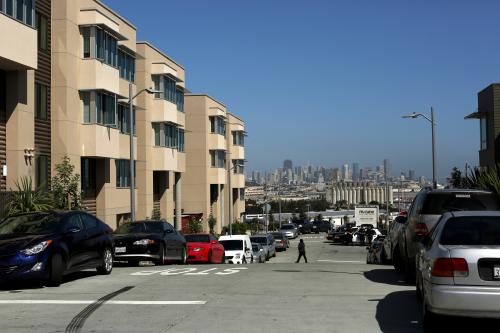In the past year, a previously obscure topic has drawn new public attention: zoning. Local regulations over how land can be developed are under fire for their role in escalating housing costs. Research shows that overly restrictive zoning makes it hard for developers to build new housing, driving up rents and prices.
State and federal policymakers—including the White House and several of the Democratic presidential candidates—have voiced interest in creating carrots and sticks to nudge local governments into reducing “regulatory barriers,” starting with zoning. But to design policies that are effective are reducing these barriers, we need to answer several questions. How exactly does zoning drive up housing costs? How can we tell whether zoning is excessively restrictive? The answers to these questions are complicated—not unlike zoning laws themselves.
In this article, I describe how zoning laws regulate housing, discuss the strengths and limitations of different approaches to measuring zoning stringency, and outline an alternative framing of the problem facing policymakers who are concerned over escalating housing costs.
How do zoning laws regulate housing development?
Most cities and counties in the U.S. have local zoning laws that regulate land use (Houston is famous for using deed restrictions and other types of local laws instead of zoning). At the most basic level, zoning laws do four things. First, they divide land into designated regions or “zones,” each of which corresponds to geographic areas on the zoning map. Figure 1 shows the zoning map for Falls Church, Va., a city of about 15,000 people just outside Washington, D.C.

Second, zoning laws specify what type of structures can be built (or not built) within each zone. For instance, all of Falls Church’s “R” zones are intended for residential uses, ranging from single-family detached homes in the R1-A and R1-B zones to apartment buildings in the R-M zones. (Note that apartments are only allowed in a small section of the city, near the commercial corridor, while about two-thirds of land is reserved for single-family homes—a pattern typical of many cities.) Other zones allow offices, retail, and industrial buildings.
Third, zoning laws proscribe limits on the size and dimensions of each structure type by zone. A selection of Falls Church’s dimensional requirements is shown in Figure 2. Standard components include the minimum lot size (the smallest amount of land on which one structure can be built), a maximum building height, and setbacks (how close the building can be to the edge of the lot in each direction).

The fourth essential function of zoning is to define the process by which local governments grant permission for new development. One approach is to allow structures to be built “by right,” meaning that proposals for new development can be reviewed and approved by administrative staff as long as they conform with dimensional requirements. Alternatively, zoning may require that certain proposed developments undergo additional reviews before approval; building types that require additional review are sometimes called “conditional use” or “special use.” The process required for conditional uses varies widely across cities and counties (and even across zones and use types within a locality), but usually requires the landowner or developer to hold public meetings where residents and advocates may voice concerns over the project. Sometimes, elected bodies such as the city council or planning board hold public votes to decide conditional use applications.
The procedural requirements of development are a critical element in determining whether housing gets built and how much it costs. A long process in which the outcome (whether or not the project will be approved) is uncertain makes development more expensive and riskier. Those extra costs show up in the rents or sales prices of the finished housing.
The four elements described above are only the start of contemporary zoning laws. Zoning can regulate a range of activities: the amount of off-street parking that must be included with new homes or offices, the type of landscaping or lighting that accompanies buildings, even the size and brightness of outdoor signs. The table of contents for Montgomery County, Maryland’s zoning code (Figure 3) runs for eight pages, while the entire ordinance is nearly 400 pages.

Is zoning a useful tool or a “regulatory barrier”?
There are good reasons why local governments want to exert some control over what kinds of structures are built where. Each component of zoning emerged to address concerns over the spillover impacts of new development on surrounding neighborhoods. Very few people would want a sewage treatment plant located across the street from their home, for instance. In theory, a development process that allows the general public to provide input offers more transparency than “by right” zoning, and could potentially allow vulnerable communities to push back against projects that would harm them, from urban renewal to highways.
While zoning can help achieve valuable social goals, excessively restrictive zoning contributes to the rising affordability problem. For researchers and policymakers, the challenge is to determine when zoning becomes too restrictive. Are there specific components of zoning that are problematic? On any given dimension, what are appropriate limits and what is too strict? Given the length and complexity of zoning laws, answering these questions is challenging.
Measuring zoning restrictiveness is conceptually and practically hard
Researchers in economics and urban planning have been trying for decades to measure zoning restrictiveness. There isn’t one central database that contains all the thousands of local zoning codes, so most researchers conduct surveys of local planning officials. A few scholars have reviewed and manually coded laws, and there is increasing interest in using technical tools such as text analysis and machine learning (Figure 4). Each method has distinct strengths and limitations.
Figure 4: Methods of measuring zoning
Authors |
Year published |
Geographies |
Survey of local planners |
||
| Glickfeld & Levine | 1988, 1992 | >350 CA localities |
| Katz & Rosen | 1987 | SF Bay Area |
| Pendall | 1994, 2006, 2019 | 1800 localities, 50 metros |
| Segal & Srinivasan | 1985 | 51 metro areas |
| UC-Berkeley Terner Center | 2018 | CA localities |
| Wharton | 2008, 2019 | 293 metros, >2500 localities nationwide |
Manually coded zoning |
||
| Dain, Glaeser, Schuetz, & Ward | 2006 | 187 localities in Greater Boston |
Other |
||
| Brooks & Lutz | 2014 | City of Los Angeles |
| Urban Institute | 2019 | Washington DC |
Starting in the 1980s, researchers tried to measure regulations through surveys asking local planners to characterize zoning in their home jurisdiction. The exact set of questions posed varies across surveys, in part reflecting the topics of most concern to particular geographies and time periods. For instance, Glickfeld and Levine focused on growth management tools, which were prevalent among California local governments during the 1990s.
Measuring zoning through planner surveys has two main drawbacks. First, like any voluntary survey, response rates tend to be low, and following up with recalcitrant participants is expensive. The best-known survey, conducted by economists at the Wharton School, had a response rate of around 40% in the second iteration (2008). And the local governments that did submit responses systematically differed from those that did not: Cities and counties with larger populations responded at higher rates than smaller communities. This is not surprising, as large cities have bigger municipal budgets and more full-time planning staff. But any systematic differences between respondents and nonrespondents will limit the usefulness of the survey responses.
Selection bias raises additional challenges when researchers want to aggregate jurisdiction-level metrics into indices that measure zoning stringency for metropolitan areas or states. The jurisdictions that did not respond may have quite different zoning rules than those that did, leading researchers to make imputations or assumptions about missing observations that may not be correct.
The second limitation to asking planners about their regulations is that staff may not have the right data to inform their answers. Even apparently straightforward questions like “What’s the typical minimum lot size required for single-family homes?” turn out to have complicated answers. For instance, Falls Church allows single-family homes by right in at least three different zones, with different minimum lot sizes required in each zone. How should the planner estimate a “typical” lot size? The one applicable on the largest share of land? A weighted average across all the zones? Something else entirely?
Other questions try to elicit data that most communities don’t systematically track. For instance, “How frequently do developers request variances, and what share of variances are granted?” This information could be collected and analyzed from administrative records, but that would require considerable staff effort.
Many surveys also ask for planners’ subjective interpretations. “Has the regulatory environment in your jurisdiction become more or less stringent over the past 10 years?” This question could plausibly elicit different answers from staff working in the same jurisdiction, depending on their length of service with the department and their personal interpretation.
Despite these limitations, zoning measures collected via survey have been a useful and valuable tool in understanding differences in local land use practices across the U.S. Many, many researchers (including myself) have analyzed these survey data and generally found that more restrictive zoning—as measured by planners’ responses—is strongly correlated with less housing production and higher housing prices. Survey data may not provide precise, literal measures of zoning, but they do capture planners’ perceptions of their local communities.
A different approach to measuring zoning that does not rely on local planners’ judgment is for researchers to read zoning laws themselves and create standardized metrics directly from the text. The main drawback to this approach is that, given the length and complexity of each law, reading the full code for many jurisdictions is extremely labor-intensive. (For my dissertation, I spent nearly a year reading zoning laws for 187 Boston-area suburbs, working with a team that included a full-time project manager and 12 research assistants.)
Some subjectivity still comes into play when deciding what metrics to include and exactly how to code them. For instance, in tracking the presence of inclusionary zoning programs, should both voluntary and mandatory programs be included? Grouped together or categorized separately? Small teams of researchers can bring more consistency to these coding decisions than surveys filled out independently by hundreds (or thousands) of local planners.
In recent years, a few researchers have started taking advantage of technological tools to capture zoning data, such as digitizing zoning maps or using text analysis and machine learning to code written laws. These tools could offer a more reliable and efficient way to capture specific zoning components (digitizing maps gives more accurate information on how much land is zoned for different uses, for instance). But technical tools still don’t get around some of the conceptual hurdles to evaluating restrictiveness.
Zoning rules on paper don’t always match development on the ground
Coding zoning laws from text—whether manually or through automated text analysis—does not address discrepancies between de facto and de jure zoning, or variation in how local governments choose to implement or enforce the laws on their books.
Local governments vary enormously in staff size and capacity and financial resources, to say nothing of the varying political environments in which they operate. It is entirely plausible that two localities could have zoning laws that look similar on paper, at least on certain dimensions, but are implemented in ways that lead to widely differing outcomes, especially when the procedure for granting permits is highly discretionary. For instance, if a local government wants to encourage development in a particular neighborhood, it can grant a variance that exempts a project from certain zoning requirements. Conversely, neighbors who are hostile to new development can leverage political pressure on city councilors or threaten lawsuits against developers to block proposals that might technically be allowed under zoning.
Assessing whether housing production in practice matches zoning rules on paper—and understanding the reason for any deviations—is extremely difficult. Most local governments don’t know the answer to this question themselves. They seldom track variances requested and granted, or the number of threatened or filed lawsuits—metrics that would be helpful to policymakers as well as researchers.
Another complication to identifying the impact of specific tools or components of zoning is that the same regulation can have very divergent effects on housing markets in different locations or time periods. For instance, a six-story maximum height for apartment buildings would be a binding constraint in midtown Manhattan, but not in rural Kansas. Developers in Manhattan would choose to build much taller than six stories in the absence of the height limit, but the economics of construction and rents in rural Kansas make it unlikely developers would build tall apartment buildings, even if no zoning limits existed. Relaxing zoning requirements will only change housing outcomes if zoning is a binding constraint in the first place.
Ask not which rules should be changed, but what outcomes we want to achieve
Trying to identify which specific policies or procedures are binding constraints on housing supply is not just technically difficult—it’s not really the most important question for policymakers to ask. Rather, they care about how well housing markets are functioning to meet the needs of current and future residents. Three questions that better capture the impact of regulation are:
- Is the housing market producing enough additional housing to meet increased demand, as driven by population and job growth?
- Within a city or metropolitan area, is new housing being built in the locations with highest demand (i.e., the neighborhoods where people most want to live)?
- Does the market provide a diverse range of housing choices that match household budgets, size, and other characteristics?
In the absence of regulatory barriers or other frictions that impede the market, housing stock should adjust to changes in demand to meet all these conditions. In future articles, I will discuss how each of these outcomes can be measured, to help policymakers assess the health of their local housing market.
The Brookings Institution is committed to quality, independence, and impact.
We are supported by a diverse array of funders. In line with our values and policies, each Brookings publication represents the sole views of its author(s).






